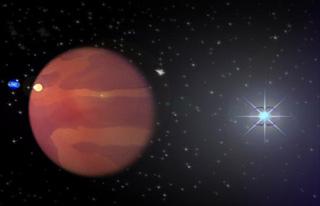
An artist's impression of the binary as it might appear from a point in space near the methane dwarf. From here the distant white dwarf would appear as a bright star, only gently illuminating its cooling companion. Photo by: Andrew McDonagh.
LONDON (BNS): Astronomers have discovered a unique and exotic star system with a very cool methane-rich (or T-) dwarf star and a 'dying' white dwarf stellar remnant in orbit around each other.
The system, which is the first of its type to be found, is a "Rosetta Stone" for T-dwarf stars and gives scientists a way of finding the mass and age of this old methane dwarf.
The two stars are low in mass and have a weak mutual gravitational attraction as they are separated by about a quarter of a light year or 2.5 trillion km (to put this in context Neptune is only 4.5 billion km from the Sun). Despite the frailty of the system it has stayed together for billions of years, but its stars are cooling down to a dark demise, as reported by the Royal Astronomical Society in a news release.
Methane dwarfs have temperatures of less than 1000 degrees Celsius (in comparison the Sun's surface is at 5500 degrees Celsius).
Methane is a fragile molecule destroyed at warmer temperatures, so is only seen in very cool stars and giant planets like Jupiter. Neither giant planets nor T-dwarf stars are massive enough for the hydrogen fusion that powers the Sun to take place, meaning that they simply cool and fade over time.
This binary is providing a critical test of knowledge of the physics of ultra-cool stellar atmospheres because the white dwarf can be used to establish the age of both objects.
"In about 6 billion years' time, when our Sun 'dies' and becomes a white dwarf itself, the stars in the newly-discovered system will have changed dramatically. The methane dwarf will have cooled to around room temperature, and the white dwarf will have cooled to 2700 Celsius or the temperature of the methane dwarf at the start of its life," Dr Avril Day-Jones of the Universidad de Chile, was quoted as saying in the report.
The methane dwarf was identified in the UKIRT Infrared Deep Sky Survey (UKIDSS) as part of a project to identify the coolest objects in the galaxy. Its temperature and spectrum were measured by the Gemini North Telescope in Hawaii.
The team then found that the methane dwarf shares its motion across the sky with a nearby blue object catalogued as LSPM 1459+0857. They studied the blue object using the world's largest optical telescope, the European Southern Observatory's Very Large Telescope (VLT) in Chile. The new VLT observations revealed the blue object to be a cool white dwarf and companion to the methane dwarf. The objects were thus re-christened LSPM 1459+0857 A and B.
The two stars are separated by at least 2.5 thousand billion km today, but would have been closer in the past. The new discovery shows that despite their fragility, such binaries are able to remain united even in the maelstrom of the galactic disc.
"Binary systems like this provide vital information and allow us to better understand ultra-cool atmospheres and the very low-mass dwarfs and planets they enshroud. The fact that these binaries survive intact for billions of years means that we could find many more lurking out there in the future," added Dr David Pinfield of the University of Hertfordshire.
The team is led by Dr Avril Day-Jones of the Universidad de Chile and including Dr David Pinfield of the University of Hertfordshire as well as astronomers from the University of Montreal.
 Previous Article
Previous Article Next Article
Next Article













The Indian Air Force, in its flight trials evaluation report submitted before the Defence Ministry l..
view articleAn insight into the Medium Multi-Role Combat Aircraft competition...
view articleSky enthusiasts can now spot the International Space Station (ISS) commanded by Indian-American astr..
view article